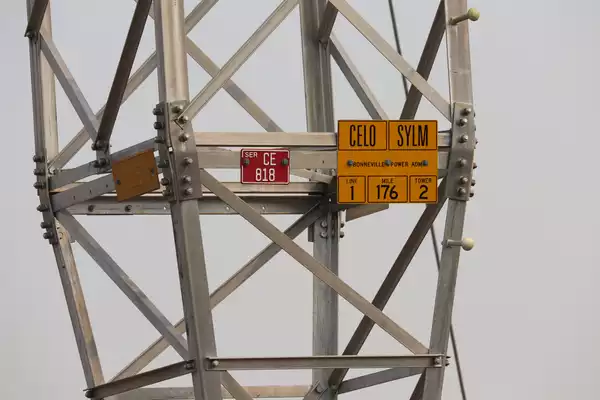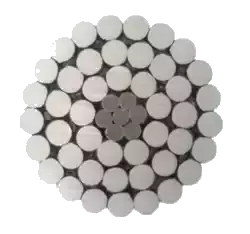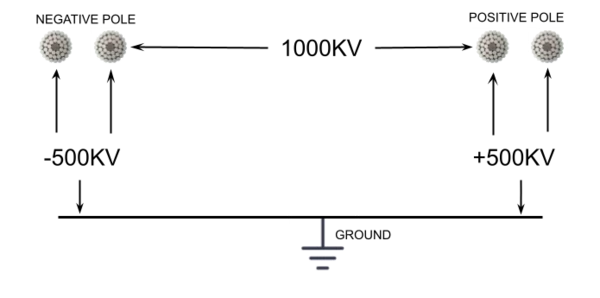The Pacific DC Intertie (PDCI) is a powerline that runs from northern Oregon to Los Angeles. Built in 1970, it carries power generated by dams and wind farms along the Columbia River for consumption in Los Angeles. It was the first long-distance, high-voltage, direct current (HVDC) powerline in the United States. It is 846 miles long and carries 3.8 gigawatts (GW) of power.

Photo by Ed Sawicki
There are a few things the existance of the PDCI suggests and myths it dispenses with.
- When Thomas Edison and the team of Nikola Tesla and George Westinghouse were engaged in their “current wars” in the late 1800s, it was not possible to move DC power over long distances efficiently, so Tesla's invention of AC power was considered far superior. Advances in technology made long-distance transmission of DC power possible about 60 years later.
- Long distance DC power transmission makes it possible to connect areas that have different power grids without the problem of synchronizing the frequency of the alternating currents. This is an element of what makes “smart power grids”.
- Critics of nuclear power sometimes say that reactors must be located close to population centers, otherwise “too much power is lost in transmission.” That hasn't been true for decades. Reactors and other electrical power sources could be located far from population centers, as the PDCI proves. Besides, modern day reactor designs, such as those based on molten salts, are far safer than early designs; It's not necessary to locate them far from population centers.
Towers
Self-supporting and guyed towers are used. All self-supporting towers are steel structures. Guyed towers are steel for the Southern section and aluminum for the Northern section. In the photo at the top of the page, the steel towers are grey while the aluminum towers are much lighter in color.

Click this button to see a map of all the PDCI's towers:
Cables

The cables are bare Aluminum Conductor Steel Reinforced (ACSR) with a cross section area of 1171 square millimeters. The photo to the left shows a cross section of ACSR cable. The seven inner wires that appear darker in color are the steel wires that provide tensile strength. Each of the two poles uses two of these cables for a total of four cables.
For a 846-mile long transmission line, there will need to be many splices. Here's a video that shows how these splices are made: PLP Compression Splice for ACSR & ACSS Conductors
Electrical
The PDCI is a direct current transmission line. Two of the conductors (acting together as the negative pole) carry -500 kilovolts with respect to ground. Two other conductors (the positive pole) carry +500 kilovolts. The voltage between the poles is one-million volts (1000 kilovolts).

Environmental impact
There is an environmental impact with building long-distance transmission lines. Each of the PDCI's towers disturbed an area of about 6,400 square feet when they were constructed. The total disturbed ecosystem for the PDCI is approximately 573 acres. There is little, if any, additional impact on that environment post-construction.
There's the additional impact to air quality caused by construction machinery and vehicles building a 846-mile powerline.
Videos
These videos have no useful audio. You can mute them if you don't want the music.
High Voltage Line construction
High Voltage Tower Construction
Sources
Terminus of Sylmar Ground Return System Being Replaced
SYLMAR GROUND RETURN ELECTRODE
ABB Completes Upgrade of First Major HVDC Link in U.S. Transmission History
BPA: Pacific Direct Current Intertie Upgrade The Dalles, Oregon to the Nevada-Oregon Border
BPA: Transmission Revenue Requirement Study Documentation, BP-20-FS-BPA-09A July 2019
Intertie Access Policy of the Bonneville Power Administration
Wikipedia: Bonneville Power Administration
BPA: Fact Sheet: Celilo Converter Station
SGL / TransGroup Heavy Lift Logistics
Wikipedia: List of HVDC projects
Pacific Intertie – Celilo Upgrade: A lifetime with ABB
The world's largest HVDC converter transformers improves power reliability
Wikipedia: Overhead power line
USA Today: William Shatner's fix for Calif. drought? A pipeline to Seattle
Benefits of High-Voltage Direct Current Transmission Systems